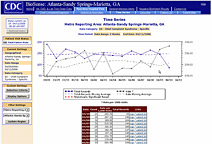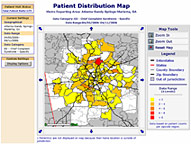
For Public Health Departments
About Biosense
Value to the Public Health Community
Early Event Detection and Health Situational Awareness
BioSense Data Sources
PHIN requirements
Syndromic Surveillance
Technical Approach
BioSense is a national program that provides real-time biosurveillance and health situational awareness for public health through use of existing data from healthcare organizations.
BioSense's Vision
The BioSense vision is:
- To provide state, local, and nationwide health situational awareness for suspect illnesses, cases of disease, and to provide a window into the community before, during, and after a health event using biosurveillance.
The approach to achieve this vision includes:
- Supporting real-time delivery of healthcare data to Public Health from hospitals, laboratories, ambulatory settings and other health data sources.
- Providing electronic “views,” analytics, and reports for national, state, and local public health, and contributing healthcare organizations.
Here are two examples of "views" available in the BioSense application. (Click to enlarge.)
Value to the Public Health Community
BioSense is valuable to the public health community because:
- It provides simultaneous access to the same data at the same time to all levels of public health;
- This can decrease delays in recognition of a problem and enhance emergency response;
- Neighboring public health jurisdictions can share information if they choose to share data;
- A national system means broader data availability by combining local and national sources; and
- There is increased capacity for biosurveillance using existing clinical and diagnostic real-time data from hospital information systems.
Early Event Detection and Health Situational Awareness
BioSense was developed to improve the nation’s capabilities for early event detection and health situational awareness. It does this by providing access to real-time clinically rich data from emergency departments, outpatient clinics, and other hospital settings and data sources.
What is Early Event Detection?
Early Event Detection (EED) is the ability to detect at the earliest possible time events that may signal a public health emergency. EED is comprised of case and suspect case reporting along with statistical analysis of health-related data. Both real-time streaming of data from clinical care facilities as well as batched data with a short time delay are used to support EED efforts.
What is Health Situational Awareness?
Health Situational Awareness is the ability to utilize detailed, real-time health data to confirm, refute and to provide an effective response to the existence of an outbreak. It also is used to monitor an outbreak’s magnitude, geography, rate of change and life cycle.
What is needed for Early Event Detection and Health Situational Awareness?
The data types used and disease indicators monitored are useful for early event detection and health situational awareness. For both functions, it is necessary to have data that are timely, valid, and optimally analyzed and presented.
BioSense uses the data it receives to help identify and characterize naturally occurring bioterrorism events or disease outbreaks.
Real- Time Data Transmission
Most real-time are currently available from large multi-hospital systems, local hospitals, state and regional syndromic surveillance systems, and LabCorp order information.
Non Real-Time Data Transmission
The three data sources which do not currently transmit data in real-time are Department of Defense (DoD) military treatment facilities, Department of Veterans Affairs (VA) treatment facilities, and Laboratory Corporation of American (LabCorp) test orders. These data are received and analyzed on a daily basis. Both the DoD and VA provide ambulatory care data in the form of ICD-9-CM diagnosis codes and CPT medical procedure codes while LabCorp provides test orders and ICD-9-CM codes associated with the reason for the orders. All data sources include additional information with each record such as patient age, gender, zip code of residence, and facility identifier and zip code.
Data Source Statistics
As of May 2008, BioSense has 563 facilities transmitting real-time data to BioSense from health systems and state health organizations. In addition,
DOD facilities list download (updated monthly)
LabCorp test orders information (navigate to Numerical Index to look up test codes)
![]() Maps of BioSense average weekly volumes for DoD and VA ambulatory care clinics and LabCorp
Maps of BioSense average weekly volumes for DoD and VA ambulatory care clinics and LabCorp
CDC's Public Health Information Network (PHIN) uses the principals and practices of the broader PHIN initiative to establish interoperable information systems that support public health preparedness.
BioSense uses PHIN architecture to make its software interoperable across public health, its partners, and stakeholders. At the core of PHIN and BioSense are commonly accepted health data standards.
PHIN Certification Process
The PHIN certification process ensures that its information systems have the capabilities necessary (“functional requirements”) and can share data and work together (“Key Performance Measures – KPM’s”) to implement a national network of capable public health preparedness systems.
Certification is based upon the system requirements and specification guides found at www.cdc.gov/phin.
PHIN certification requires two types of certification:
- Validation of PHIN functional areas
- Validation of specific Key Performance Measures
To be functionally compatible, awardees must demonstrate that their systems are capable of supporting the standards outlined for each of the PHIN functional areas. The PHIN functional areas targeted for certification include:
- Early Event Detection
- Outbreak Management
- Countermeasure and Response Administration
- Partner Communications and Alerting
- Connecting Laboratory Systems
Guidance for PHIN certification requirements can be found at:
http://www.cdc.gov/phin/resources/certification/
Additional detail regarding PHIN standards can be found at http://www.cdc.gov/phin.
Syndromic surveillance refers to surveillance using health-related data that precede diagnosis and signal a sufficient probability of a case or an outbreak to warrant further public health response.
Though historically syndromic surveillance has been utilized to target investigation of potential cases, its utility for detecting outbreaks associated with bioterrorism is increasingly being explored by public health officials.
Syndromic Surveillance Resources
- www.syndromic.org* - This site contains electronically available tools, frameworks, and national systems for syndromic surveillance systems.
- btsurveillance.org/* - This site highlights the National Bioterrorism Syndromic Surveillance Demonstration Program.
- www.bt.cdc.gov/surveillance/ears/* - The site showcases the Early Aberration Reporting System where experts from various agencies participated in the mapping of each data source to various syndrome categories.
- www.bt.cdc.gov/surveillance/syndromedef/index.asp - This site highlights the document entitled “ Syndrome Definitions for Diseases Associated with Critical Bioterrorism-associated Agents” which explains the ICD-9 mapping to syndrome categories used in BioSense .
-
 BioSense CPT (Current Procedural Terminology) Mapping to Syndrome Categories
BioSense CPT (Current Procedural Terminology) Mapping to Syndrome Categories
*Links will navigate your browser away from CDC's TIPS Web site. To return here, use your browser's Back button.
BioSense will coordinate with local and state public health for early event detection, health situational awareness and outbreak coordination.
- Industry-accepted standards will be applied in the coding and transmission of data.
- Funding is available to address incremental costs of hospital / health system participation.
- The data feed from the hospital can be enabled for the local public health department to provide data to CDC and local public health simultaneously.
The technical approach in collaboration with the Public Health Information Network (PHIN) is described in this document.
Page Last Modified: Dec 8, 2008

